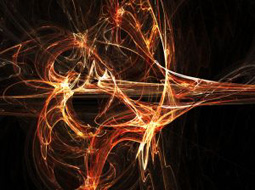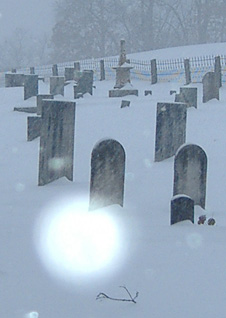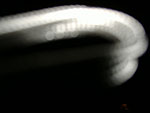As an Amazon Associate I earn from qualifying purchases. Click for details.
 Sometimes, people are understandably eager for something to be a ghost. A haunted house or graveyard can seem so exciting. A “real” ghost experience grants instant celebrity to the storyteller.
Sometimes, people are understandably eager for something to be a ghost. A haunted house or graveyard can seem so exciting. A “real” ghost experience grants instant celebrity to the storyteller.
I wrote this article back in the 1990s, and it’s still valid today, though our research techniques — and cameras — have changed.
Sometimes the obvious is most easily overlooked, especially under stress, late at night, and in an unfamiliar setting where everyone’s nerves are on edge.
Haunted houses
Do a reality check before deciding that an odd experience is a ghost.
- If an object seems to move by itself, check the floor or surface with a carpenter’s level. You can pick up a cheap one for under $2, and it’ll fit in your purse or pocket. If the object is lightweight, check for drafts, too.
- If you sense a cold spot, check it with a thermometer. Use a candle or other draft detector, to see if you can find where it’s coming from. In old houses, I often find drafts from electrical outlets on outside walls that are not insulated. Check around light switches, too. Carry a roll of masking tape with you, as a short-term way to shut out these drafts.
- If you hear ghostly footsteps, wait until the phenomenon has stopped (or until daylight, if you’re more comfortable) and try to duplicate the sound by walking wherever the footsteps came from. Was it really footsteps, or the house settling or shifting as the temperature dropped at dusk?
- If windows open themselves, check the hardware. Make certain they’re really closed. Try the window to see if the counterweight isn’t right, and the window opens too easily.
- If windows close themselves, try propping them with a piece of pipe or other solid object. Ghosts pop those props out, gravity usually doesn’t.
- Snapping window shades can mean defective hardware. Or, maybe the coil has been too-tightly or too-loosely wound. Let it release, and then rewind it yourself.
- If you genuinely think it’s a ghost and you’re in the dark, use caution when turning on lights. In our experience, lights usually banish the phenomenon. However, shortly after turning the lights off again, if it was a ghost, he (or she) may return with a vengeance. If you’re nervous, leave the location and return again in daylight hours to look for natural causes of what you witnessed.
- Poltergeist phenomena is its own animal, so to speak. First, try to repeat the incident yourself, using natural means that could have occurred the first time. (A dish can fall off a shelf if the shelf is shaky. A dish cannot fly across the room and smash on the wall unless someone threw it, or rigged it.)If you cannot duplicate what happened, keep a log of similar events that occur at this location in the future. Often, the energy source for poltergeist phenomena is a teen or pre-teen. (Though the spirit itself may be very real, and is not always the same as the “focus” of the energy.) More poltergeist events will happen when the energy source is nearby, so you’ll have less activity during school hours, for example.
- However, do NOT get caught up in what I call the “Randi complex” (referring to skeptic James Randi). Just because you can make something happen, doesn’t mean that the phenomenon is a fraud, hoax, or error in judgement.Yes, I can probably rig stairs so they sound as if someone is walking on them. No, that doesn’t mean that all stairways have been rigged when people hear spectral footsteps on them.
Ghost photos
Most people are careful when taking “ghost photos.” However, even the most experienced photographer can forget the basics.
My best advice is to deliberately break every possible rule (from the list below), to see what it looks like in your photos taken with that camera. Then, if you see that kind of orb or anomaly again, you’ll know what it might be.
-

Snow orb. Do not point your camera towards the sun, or so the sun can highlight something on your lens. There are devices made to prevent this, if it’s a regular problem.
- Notice weather conditions. Rain, snow, and high humidity can produce orbs. They’re usually easy to distinguish from anomalies, but learn what they look like, anyway.
- Make certain that nothing reflects the sun towards your lens, such as a polished gravestone, a foil candy wrapper in the grass, a metal veteran’s marker, your car windows/trim, rings on your fingers if one hand is supporting the front of the camera, and so on.
- This will sound silly, but these things can happen at the worst moments: Watch for floating milkweed or dandelion “puffs” that can look like orbs in the sunlight. If they appear, do not take photos until they’re gone. Or, take notes so you remember when whatever-it-was might have affected your photo. Do NOT think “Oh, I’ll remember that photos 5 and 6 are just milkweed thingies.” You won’t, three years from now when you review your photos as you’re clearing out your files.
-

This is a flash photo of a black camera strap. It can never be said too often: If your camera has a strap, remove it or put it around your neck (or wrist, if small) while taking photos. Even black camera straps look vivid white when they reflect light from your flash camera.
- Take two photos of everything, as closely together as you can, without moving an inch. Then, if it’s a reflection, it’ll be in both photos and the same. If it’s an anomaly, it’ll either move or vanish. Anomalies are usually static. They are actively moving and will be different in two consecutive photos.
- If you’re sharing a photo online, try to make an uncompressed, unmodified print available for viewers. This prevents people from saying, “Oh, she just increased the contrast to make that look more dramatic.” (However, if a critical skeptic is convinced you’re deliberately faking your photos, nothing will change his or her mind.)
- If you’re using a film camera, the following will produce false anomalies in film photos: fingerprints on the negative; a folded negative; a scratched negative; rushed printing at the one-hour (check the index print, which should be fine); very old film; film left in a hot car for too long, or in the hot sun; film that goes through the “old” metal detectors in airports (most airport scanners are fine now.)
Also, see my article, Are Ghost Orbs “Paranormal”? to see why I’m concerned about photos, and what we think cause false orbs. It’s not as easy to take a “fake orb” photo as I once thought.
In general, it’s important to rule out normal causes for what seems to be a paranormal event. Experience is the best teacher and will save you hours of confusion as well as embarrassment if a simple explanation is found.
